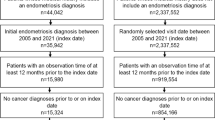Abstract
Purpose: The objective of the present study was to determine the prevalence of endometriosis among the relatives of patients with confirmed endometriosis.
Methods: We analyzed the prevalence of endometriosis among first-, second-, and third-degree relatives in a group of 101 patients with varying symptoms related to endometriosis seen at two public hospitals and submitted to laparoscopy and/or laparotomy. The control group consisted of 43 women submitted to laparoscopy without a diagnosis of endometriosis.
Results: Among the patients with endometriosis, we detected nine families with a positive history of endometriosis, comprising one mother, six sisters, three aunts, and two cousins, as opposed to no case among the controls.
Conclusions: These data confirm a familial tendency for endometriosis and suggest that this disorder has a genetic basis.
Similar content being viewed by others
REFERENCES
Ranney B: Endometriosis. IV. Hereditary tendency. Obstet Gynecol 1971;37:734-737
Simpson JL, Elias S, Malinak LR, Buttram TR: Heritable aspects of endometriosis. Am J Obstet Gynecol 1980;137:327-331
Lamb RNK, Hoffmann R, Nichols TR: Family trait analysis: A case-control study of 43 women with endometriosis and their best friends. Am J Obstet Gynecol 1986;154:596-601
Moen MH, Magnus P: The familial risk of endometriosis. Acta Obstet Gynecol Scand 1993;72:560-564
Kennedy SH, Mardon HJ, Barlow DH: The Oxford endometriosis gene study. In Abstracts of the 2nd International Meeting of the BFS, Glasgow, 1994, p 11
ASRM: Revised American Society for Reproductive Medicine classification of endometriosis: 1996. Fertil Steril 1997;67:817-820
Donadio N, Nobrega AC: Leiomyomata plus endometriosis: Simultaneous treatment with gestrinone and buserelin acetate before in vitro fertilization-embryo transfer. In Progress in the Management of Endometriosis, EM Coutinho, P Spinola, LH Moura (eds). London, New York, Parthenon, 1995, pp 135-137
Arnold LL, Meck JM, Simon JA: Adenomyosis: Evidence for genetic cause. Am J Med Genet 1995;55:505-506
Pandis N, Karaikos C, Bardi G, Sfikas K, Tserkezoglou A, Fotiou S, Heim S: Chromosome analysis of uterine adenomyosis. Cancer Genet Cytogenet 1995;80:118-120
Oziaik YY, Meloni Am, Surti U, Sandberg AA: Deletion 7q22 in uterine leiomyoma. A cytogenetic review. Cancer Genet Cytogenet 1993;71:1-6
Moen MH: Endometriosis in monozygotic twins. Acta Obstet Gynecol Scand 1994;73:59-62
Author information
Authors and Affiliations
Rights and permissions
About this article
Cite this article
Dos Reis, R.M., Silva De Sá, M.F., De Moura, M.D. et al. Familial Risk Among Patients with Endometriosis. J Assist Reprod Genet 16, 500–503 (1999). https://doi.org/10.1023/A:1020559201968
Issue Date:
DOI: https://doi.org/10.1023/A:1020559201968




